TIFF Countdown -3: Crazy Horse / Among Us / Amy George / Cuchera / Cut / Footnote / Keyhole / Last Days in Jerusalem / Mushrooms / Pink Ribbons, Inc. / The Silver Cliff / A Simple Life / Think of Me / The Year of the Tiger
Cinema Scope 48 Preview: Crazy Horse (Frederick Wiseman, France/US)—Real to Reel
 By Mark Peranson
By Mark Peranson
Over the last decade, I’ve realized that Frederick Wiseman devotees are incapable of critical thinking when it comes to their master. They fail to see (or refuse to acknowledge) that in composing his career-long grand narrative analysis, Wiseman sometimes loses sight of the particularities of the institution under observation; at times, he’s been just plain lazy as an editor. To what extent his unofficial status as the chronicler of American life has weighed upon him as a burden I can’t say, but my complaints disappear into the shadows in Crazy Horse, his 39th film, and, for my money, the most entertaining movie he’s ever made. Maybe this has something to do with Wiseman’s differing takes on the American and French nations. Put another way, America for Wiseman is high school, legislature, public housing, hospital, the army; France is the Comédie Française and strippers. (Common ground is found in ballet.) In both definitions of the word, Le Crazy is indeed an institution.
In the press kit for Crazy Horse, Wiseman states he made it because “I thought the idea amusing.” And this is perhaps the best reason to make a film. To be fair, he continues to list other issues that interest him: the difference between cabaret and ballet (again, cabaret, more amusing); the way the Crazy Horse isn’t really vulgar but hints at vulgarity; and, crucially, the topic of erotic fantasy and the body. The club’s legendary opening number, “God Save Our Bareskin,” which Wiseman withholds until close to the end, sees the ladies sporting Buckingham Palace guard bearskin hats and not much else, parading across the stage in near-military manoeuvres. Allowing for some imagination—which is what the film, bracketed by two scenes of staged shadow play, is essentially about—we’re not that far from what Wiseman captured in Basic Training (1971).
After some elegant punctuation scenes that will reappear over the course of the film, taking us either off-stage or out of the club, Wiseman begins the film with a too-lengthy montage of Crazy Horse numbers, most filmed in close-up and too-long takes, most with a bevy of buttocks proffered up to the camera. Trouble, I thought, but it’s a fake-out. Though of course no narration or background is provided, Wiseman is showing us the mostly unsubtle numbers that have been performed at the club for years (such as “Baby Buns”); and judging from a perfunctory 2003 documentary produced by the cabaret itself, which sprints through the entire hour-long show of 15 numbers, Wiseman’s chosen some restrained ones. After this, Crazy Horse slowly finds a convincing structure as it focuses on the development of a new show choreographed and directed by Philippe Decouflé (a trained mime and the brains behind the Albertville Olympics opening and closing ceremonies) titled, in figurative and literal six-foot-high letters, DESIRS.
Decouflé’s charge is to create a dazzling premiere that will “impress the intellectuals,” but is burdened with the need to rehearse new numbers while the poor dancers are performing the old show every night. A seemingly principled and well-intentioned artistic mind, he is wont to expound on the need to “face what creation is about”; in the first staff meeting, we see the classic art vs. commerce battle as Decouflé attempts to convince the managing director, Andrée Deissenberg, to give him more time and resources to realize his vision. (Le Crazy may be an institution, but it’s a private one.) Throughout the whole film, there’s something incredibly charming—Wiseman might say inherently “French”—about the totally irony-free pronouncements about art and legacy when it comes to a chic nude revue. This comes to a beret-topped head when Wiseman reveals his trump card: the flaming “artistic director” Ali Mahdavi, who has seen various permutations of the show 40 times. His Le Crazy obsession follows, chronologically, “Saint-Laurent, Marlene Dietrich, Helmut Newton,” and his motto is “There are no ugly women…only lazy ones.” (I could go on for the rest of this review about Ali, but some things are better discovered for oneself.)
The periodic appearance of endearing lunatics—the put-upon costume designer who describes a tiny skirt as “more elegant, like for a female CEO,” and later delivers the precious line, “You don’t take chances with a naked girl,” being one of them—is one thing that keeps the entertainment value at a high level. But to everyone’s credit, the dance performances convince us that this nude revue is an art on par with ballet, or Bob Dylan or Bono. It doesn’t hurt that, as a friend noted, Wiseman’s HD camera, with cinematography by John Davey, captures the greatest colours seen in cinema since the death of Paul Sharits. Employing a wide array of gels, projections, effects (polka dots, leopard patterns), and front and side lighting, the eye-popping, often narrative numbers at the Crazy Horse are drop-dead cinematic—at times they approach kaleidoscopic op art. Often, all that Wiseman wisely does is let a scene play out in a long take and let the astonishment sink in. The dancers’ bodies themselves are cinematic vehicles, either used to produce shadows on coloured backdrops, or as objects themselves onto which light and image is projected.
Cinema in essence involves the projection of desire, and what Wiseman cleverly does in Crazy Horse is present desire, illustrate its operation and deconstruct it, with the technical rehearsals of the numbers showing the peculiar sweat and effort required to create this seamless illusion. (While arguing with Ali over the grand finale, Decouflé demands, “Can I have an almost naked girl inside the letter?”) Along the way, Wiseman also allows for the intellectualization of desire: pace Plato, it’s important that the dancers are indistinguishable from each other in order to create the ideal conditions for the perpetuation of desire. And make no mistake, as seen in a priceless audition scene, the women are definitely seen as objects, even by their employers (except when they’re transvestites). To drive it home, Wiseman often shoots a scene without allowing for a glimpse of the dancer’s face, preferring a longing gaze at yet another shapely buttock, making for a point of view not only masculine, but cinematic (rather than theatrical). Yet as Deissenberg points out, Le Crazy famously appeals to women and men alike—but maybe women even more. For here, through the fusion of art and eroticism, through frustration and imagination, women are being given more than just “the desire to desire.”
Still, the film could be a little shorter.
Among Us (Marco van Geffen, The Netherlands)—Discovery
 By Robert Koehler
By Robert Koehler
From its dated, Reservoir Dogs-era windback narrative structure to its gratingly uncommunicative and mousy central character, Dutch filmmaker Marco van Geffen’s misbegotten study of alienation between the hired help of Europe’s east and their disinterested western employers screams out for revision and rethinking. Van Geffen may intend to present an impossible set of affairs as simply beyond repair, even beyond comment: hired nanny Ewa (Rifka Lodeizen, who’s certainly dedicated to her assignment) takes on the role of caretaker with no real interest or care, refuses to speak when spoken to, and can’t make the right decisions about 100% of the time. She is, in sum, a walking disaster, but worse, undermining Van Geffen’s undoubtedly politically correct stance, her overwhelming weakness and anti-social tendencies turn her into a freak show for our observation. If anything, Among Us merely demonstrates a middle-class filmmaker’s alienation from working-class realities, and in this case, a male filmmaker’s utter cluelessness in dealing with a paradoxical female character.
Amy George (Yonah Lewis & Calvin Thompson, Canada)—Canada First!
 By John Semley
By John Semley
Amy George is a modest first effort from two recent grads of Toronto’s Sheridan College film program. Like half the first features at TIFF (the Discovery section is crammed with them), Amy George is a delicate coming-of-age story trailing thirteen-year-old Jesse (Gabriel del Castillo Mullally) as he stumbles towards an adolescent sexual awakening. Raised by some blandly liberal parents, Jesse’s underexposure to TV, the internet, Playstation, and sundry other porn-and-violence delivery systems leaves him less informed about the hyper-sexuality enriching other kids his age. In one of the film’s funnier scenes, Jesse’s mom (T.O. “Coupling” columnist, gadabout, and self-promoter Claudia Dey) happens across a man waiting in the bushes on a family hike and has to tenderly explain the mechanics of cruising.
Charged with a school photography assignment hinging on self-expression, Jesse begins to believe that suffering and lovemaking are the keys to great art. Killing two birds with one stone, he begins lurking around the titular Amy (Emily Henry), who seems to alternatively reject and encourage his awkward advances. This gawky stagger towards artfulness more-or-less defines Amy George, a film with scenes of intermittent sweetness undercut by too many framing Jesse’s hangdog grumblings. Likewise, while there’s some charm in Jesse’s eventual groping expedition of sexual self-discovery, it seems almost impossible that any kid living in a major city in the year 2011, no matter how alienated, sheltered or henpecked, wouldn’t have figured out the physical logistics of masturbation by the time he was eight.
Cuchera (Joseph Israel Laban, The Philippines)—Discovery
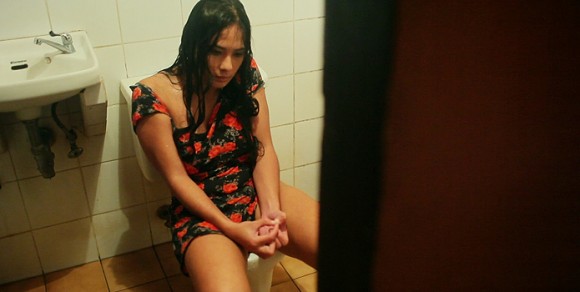 By Adam Nayman
By Adam Nayman
Every conceivable orifice gets plugged in Cuchera, a purposefully squalid drama about Filipino drug mules that seems bent on stimulating the gag reflex on either side of the screen. A scene detailing an agonizing experience at a faith healer’s parlour sets a precedent for suffering and physical violation that the rest of the film endeavours to live up to: by the time the characters start preparing in earnest for an elaborate yet completely addled drug-transport operation, the dialogue has been reduced to the likes of “I’m going to put more drugs into your anus.”
The question is whether there’s more here than an extended, visceral illustration of what the opening title card tells us in black and white: that the Philippines is an epicentre for the illegal narcotics trade. Writer-director Joseph Israel Laban has a background as a journalist, which may be why the small details (clandestine exchanges, haggles over money, excruciating bowel movements) feel so finely sketched. He’s not much of a dramatist, though: the entrepreneurial ambitions of veteran smuggler Isabel (Maria Isabel Lopez) are merely a functional entry point into what is basically docudrama territory. He’s not much of a stylist, either: his M.O. is to keep the camera trained on the characters at close, queasy proximity, spiking certain tense moments with a rush of soundtrack noise. It’s pounding filmmaking, and if it’s undeniably effective on a gut level, it’s finally queasy in a way that’s not exactly laudatory.
Cut (Amir Naderi, Japan)—Visions
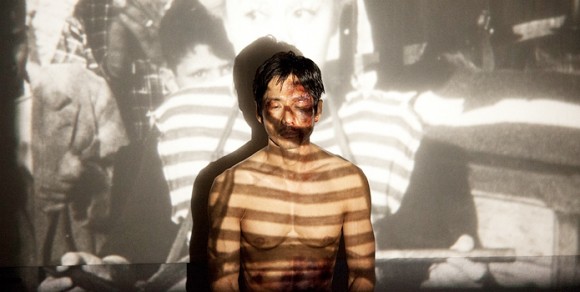 By Gabe Klinger
By Gabe Klinger
Surely one of the most bizarre and upsetting commentaries on cinephilia ever committed to film, Cut centres on a loner cine-club organizer in Tokyo named Shuji, who wanders the streets decrying contemporary audiences for supporting what he terms “shit cinema.” Almost Mishima-like in his radical, slavish devotion to the art form, he selects canonical films (think something close to Sight & Sound’s best-of-all-time list) and projects them in 16mm on the patio of his rooftop pad to fellow devotees. Shortly after discovering that he has to repay a large debt left by his deceased brother, Shuji begins to divide his time between running the club and acting as a punching bag-for-hire at a yakuza boxing gym, where thugs pay hard cash to kick the living shit out of him. As Shuji sustains blow after blow, he thinks of his favourite films and filmmakers for strength: Ozu, Ford, etc. He converts this routine into a kind of demented cinephile sacrifice, paying for the sins of those who flock to the megaplexes, and ultimately counting down his one hundred favourite films—which get enumerated on screen in the final sequence—as he endures his most severe pummeling yet. Cut is Iranian ex-pat Amir Naderi’s first film made in Japan (he emigrated to the US in the early ‘90s), and it’s clearly one of his most personal. Shuji’s dilemma is shared by Naderi, a filmmaker/activist battling against numbing commercial trends whose budget woes have occasionally set him on the path of humiliation and bodily harm. I don’t doubt Naderi’s sincerity—even as I cringed at the hackneyed idea of the film canon as it’s presented in Cut—but the film’s metaphorical directness has the tendency to lessen rather than amplify Shuji’s passion for the medium.
Footnote (Joseph Cedar, Israel)—Contemporary World Cinema
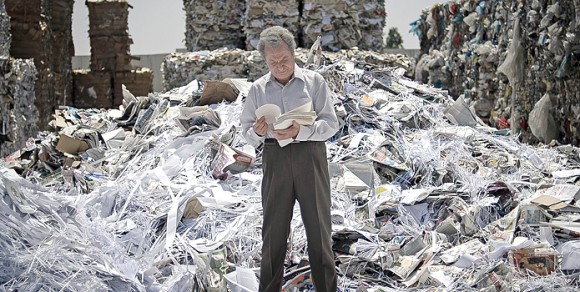 By Shelly Kraicer
By Shelly Kraicer
If Henry Kissinger really invented the apercu “academic politics are so vicious precisely because the stakes are so low,” it would have been the cleverest (and probably the least evil) thing he ever said. Joseph Cedar’s brilliant academic comedy Footnote is an elaborate, witty, and deeply human investigation of that idea, and much more.
Cedar frames his story as a post-Oedipal (or perhaps it’s post-Northrop Frye) struggle between two Hebrew University-based Talmudic scholars: senior philologist Eliezer Shkolnik (Shlomo Bar Aba) and his son Uriel (Lior Ashkenazi). Public speeches notwithstanding, the pair’s relationship is tinged with a furious rivalry: Eliezer thinks his son is a superficial celebrity scholar, while Uriel resents the senior Shkolnik’s lifelong immersion in textual minutiae. Eliezer is also terminally aggrieved that his work has never won the Israel Prize, the pinnacle of state recognition. When a minor bureaucratic snafu brings the father-son tension to a head, academic infighting takes on the potential dimensions of Greek family tragedy, but always in comic-satiric mode. As Uriel, Ashkenazi (Late Marriage) evinces arrogance, insecurity, and an interesting depth, although Shlomo Bar Aba (a popular Israeli stage and TV comic) doesn’t have the flexibility to modulate much between his comedic and brooding registers.
That a film not only cares about philogocial discovery but actually finds ways to visualize and dramatize its excitements (small differences in historical versions of the Talmud give hints about the original texts and historical variations therein) is a small miracle of cinematic art. Cedar brings a post-Amélie panoply of snazzy techniques to the (editing) table: snappy headings, animated interludes, plays with colour. Most entrancing is his use of music, a lush, insistently, naggingly (Jewish-voiced?) post-Mahlerian score that subtly ironizes, underlines, or puts musical “air quotes” around his narrative material. The resulting critical distance both incites the audience to think hard about what we’re seeing, and resonates nicely with issues of critical practice that the characters are grappling with. One might want to question the seriousness of an Israeli film that ignores “the situation” for concerns so apparently insular, but the ominous presence of tough-looking security guards at the gates of every institution the Shkolniks pass through doesn’t allow one to forget exactly where and when this struggle over truth and values is happening.
Keyhole (Guy Maddin, Canada)—Special Presentations
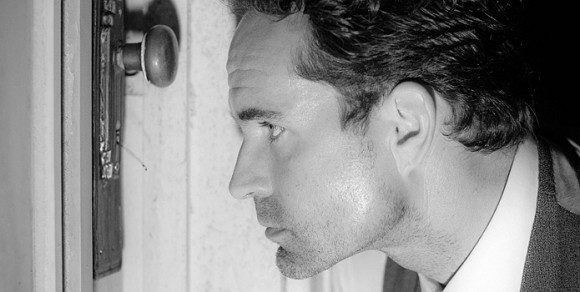 By John Semley
By John Semley
Whispers that the latest from Winnipeg’s favourite son had been rebuffed at European festivals before landing on Toronto’s doorstep engender a suspicion towards it, as if it’s typically Maddinesque gestures were just that: typical, tired, by the numbers. Granted, Maddin is once again working through his favourite hang-ups here: memory, family, and odes to forgotten film genres so consigned to oblivion that they never existed at all (in this case the Joycean gangster-haunted house picture). But Maddin finds new footing here, and his best leading man since Careful‘s Kyle McCulloch in Jason Patric, whose classic, rock-jawed good looks and tendency to play the silliness and surrealism totally straight, as if he’s just happy for the job, make Keyhole feel like considerably more than another exercise in Maddinalia.
In a hazy credits montage, bullets wing, ding and ricochet as a group of gangsters shoot their way past police to hole up in the haunted family home of their boss, Ulysses (Patric), who arrives shortly thereafter with a soaking wet medium, Denny (Brooke Palsson). In a quest befitting his name, Ulysses pokes through his old house with Denny in an attempt to locate what is either his wife, Hyacinth (Isabella Rossellini, who’s given surprisingly little to do), or her ghost. His slog is beset on one side by the gangsters in the drawing room conspiring against him (including Kevin McDonald, who’s quickly dashed when he attempts to mount one of the house’s spirits), and on the other by Hyacinth’s buck-naked father (Louis Negin, again assuming the role of perverse primal father a la Maddin’s shorts Sissy Boy Slap Party II and Glorious), who seems to be manipulating the space of the house itself to stymie Ulysses’ journey.
Requisite winks to Homer abound, of course—the “cyclops” here is a rubbery cock poking through a gilded glory hole, another nod to Glorious—but all the nostalgic po-mo business works in service of Maddin’s accomplished compression of time and space, and of time into space, with Ulysses’ conversations and quarrels with spirits from times past recalling the temporally-contracted spaces of Tony Scott’s Deja Vu. Maddin’s first long-form “talkie” shot digitally, Keyhole may lack the cruddy tactile quality of his previous features, but the almost startling crispness of the images makes this the first Maddin film about memory that’s not moonlighting as a reminiscence for the cinema itself.
Last Days in Jerusalem (Tawfik Abu Wael, France/Israel/Palestine/Germany)—Contemporary World Cinema
 By Robert Koehler
By Robert Koehler
Cinema is full of mysteries, one of the more minor of which is: how did anyone in their right mind allow Tawfik Abu Wael’s Last Days in Jerusalem out of captivity and into the world? It was cruel enough to let this blind, dumb and deaf film free to roam in Locarno’s international competition, where it was pronounced dead on arrival. (Talk about roadkill.) But now the sorry creature has been dragged across the Atlantic to an unsuspecting Toronto public that, perhaps foolishly, trusts in the capacities of the TIFF programming team to give them the best from the festival circuit. Well, how about the worst? It’s hard to get worse than this, a spectacularly ridiculous depiction of the Middle East’s (hell, maybe the world’s) most annoying couple, an upper-middle-class group of Palestinian hipsters set to split their homeland for supposedly greener pastures. Yet, wouldn’t you know, they just can’t seem to get from their vacated apartment to the airport without getting distracted by work, sex (not with each other) and just about anything other than making their plane on time. Wael’s knack for making molehills out of mountains is one of the more dismaying spectacles on screen this year.
Mushrooms (Vimukthi Jayasundara, India/France)—Visions
 By Michael Sicinski
By Michael Sicinski
Mushrooms is a solid but oddly distant family drama. The combination of close attention to a select few members of a clan with an odd lack of deep psychological characterization produce the sense that an allegory may be hovering just beyond comprehension’s grasp, even though there are no actual clues to indicate its presence. The film centres on an architect named Rahul (Sudip Mukherjee) who has just returned to Kolkata from Dubai. This reunites him with his younger girlfriend Paoli (Paoli Dam), but he also decides that he must finally locate his brother (Sumeet Thakur), who went insane years ago and now lives in a forest, playing naked in the trees. (We see him tormenting/seducing a European border guard in the opening moments of the film who seems equally unbalanced, haunted by the one hundred men he has killed.) So Jayasundara has the basic thematic elements in place — modernity vs. the primitive, borders and their breakdown, the eruption and suppression of the past as a nation’s untidy unconscious. Nevertheless, there’s an unnerving feeling that Jayasundara works his way through all of this as though Mushrooms’ “stakes” existed only in inverted commas. Part of this is formal. That opening sequence, with two historically-burdened lunatics frolicking in the forest, owes virtually everything to Apichatpong: stilted homoeroticism, the play of light through foliage, the movement of the camera through a thicket whose verdant expanse is sliced by the incongruity of human flesh. In the first 20 to 30 minutes, Jayasundara also throws in some nods to his betters—Claire Denis here (isolated military man clinging to a faded regime), Jia Zhangke there (imposing, late-capitalist building sites intercut with the exploited workers who erect them)—but mostly it’s a Joefest until Mushrooms becomes conventional, almost obsessively constricted.
Pink Ribbons, Inc. (Léa Pool, Canada)—Real to Reel
 By John Semley
By John Semley
The pink ribbon, that omnipresent symbol of breast cancer awareness, used to be salmon-coloured until it was focus-grouped to its present colour, deemed the most comforting and warm-fuzziest. It’s one of many interesting revelations in Pool’s Pink Ribbons, Inc., her first doc since her 1997 TV film about French-Canadian author Gabrielle Roy. Taking her cues from the book of the same name by Queen’s U prof Samantha King, Pool unravels the loopy deceptions entwining the pink ribbon as a symbol for solidarity among the “breast cancer community,” and the community itself.
What’s refreshing about Pink Ribbons, Inc. is its elevated level of discourse, especially considering the delicate subject matter. Pool, and many of the subjects she profiles, isn’t insensitive enough to openly lambaste everyone involved with Walks for Hope, Jumps for the Cure, and other popular forms of cancer awareness slacktivism. But by and large, Pink Ribbons, Inc. casts its gutsy glare at the problems with the contemporary culture of breast cancer: the focus on cure-seeking rather than public health promotion, the sinister level of ubiquitous corporate sponsorship, and the manner in which all these fund-raising walks, runs, and jumps have sterilized the more radically galvanizing protests and marches that defined the response to the breast cancer epidemic in the ‘80s and ‘90s.
As the film wears on, and the differently shocking revelations begin to pile up, the women and men yelling and cheering and holding hands in massive crowds shift from seeming heroic to kind of pathetic, albeit through no fault of their own. This, though, only speaks to how brassy the film really is: not only evaluating the cancer “industry,” but bold enough to work double-duty as an unflinching, strikingly unsentimental critique of capitalism itself.
The Silver Cliff (Karim Aïnouz, Brazil)—Contemporary World Cinema
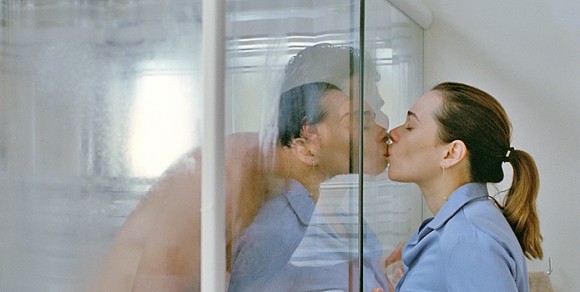 By Gabe Klinger
By Gabe Klinger
Anyone who has ever passed through one of Rio de Janeiro’s coastal neighbourhoods is likely familiar with the sight of its citizens parading around downtown streets in skin-tight bathing suits. It’s one of many small but important cultural traits that help to define this schizophrenic city, which can alternate between stressful urban centre and laid-back beach town within the span of a single city block. In the opening sequence of The Silver Cliff, Karim Aïnouz pays tribute to the unique mood of Rio when one of its characters, Djalma (Otto Jr., a mainstay on Brazilian soaps) emerges from the ocean, steps out on the sand in his speedo and, still dripping from his swim, walks through the heavy bustle of commuter traffic to reach home. The day has begun, and we see Djalma engage in robust sex with his wife Violeta (Alessandra Negrini, perhaps familiar to cinephile audiences as the titular heroine in Júlio Bressane’s wonderful 2007 Cleopatra) before he and his family go about their morning chores. A few hours later, Djalma leaves Violeta a voice message that he wants to end their marriage. The rest of the film is about Violeta’s interior journey as she comes to terms with Djalma’s decision.
Aïnouz relies largely on mundane details to try to convey Violeta’s range of feelings that go from despair to eventual acceptance of the situation. The delicate, unassertive style recalls Hou Hsiao-hsien in the near trance-like power of certain scenes, while also evoking the lyrical music of Rio-born composer Chico Buarque, whose song “Olho por olho” the film is said to be inspired by. The high point of the film, set in a nightclub, has the 40-year-old Violeta cathartically rocking out to Michael Sembello’s “Maniac,” certainly the most animated use of the synth-pop classic since Chris Farley’s lively rendition of it in Tommy Boy (and I really do mean that as a compliment). Technically, this was one of the best-looking and -sounding films in Cannes, taking full advantage of its 5.1 mix and 35mm lensing (it also had the distinction of being one of among a very small handful of films shown at the festival in 35mm – a rarity these days).
A Simple Life (Ann Hui, Hong Kong/China)—Special Presentations
 By Shelly Kraicer
By Shelly Kraicer
After an elderly maid for a Hong Kong film producer has a stroke, he finds a nursing home for her to move into. With that simple premise, based on the real life story of producer Roger Lee and his actual family’s amah Chung Chun-tao (aka Ah Tao), Hong Kong director Ann Hui has crafted one of her greatest films. This low-key masterpiece of almost documentary realism features big stars and non-professionals: king of Hong Kong cinema Andy Lau plays Roger and the remarkable actress Deannie Yip plays Ah Tao, while the home’s elderly residents play themselves.
Quiet, polite, almost diffident Roger (he’s at one point mistaken for taxi driver, going on to claim he’s an air conditioner repairman) negotiates film budgets for a living. At home, he’s aided by his family’s long time maid, or amah, Ah Tao, who’s been with his family for four generations. She’s a tough bargainer in her own right, buying just the right ox tongue in the market for Roger’s favourite stew. But when she collapses from a stroke, she’s the one who needs to be cared for. According to her wishes, Roger finds a nursing home for her to live in. She gradually integrates into a new society with strong characters each with their own stories.
Deannie Yip, winner of two Hong Kong Film Awards over twenty years ago, is remarkable as Ah Tao, embodying a quiet but vibrantly alive woman whose spirit, once sharp, now flickers with age. Andy Lau’s performance gives her perfect support: reserved, subtle, self-effacingly warm. Ann Hui’s brilliant filmography extends back to 1979, and this new work instantly earns pride of place as one of its glories.
Think of Me (Bryan Wizemann, US)—Contemporary World Cinema
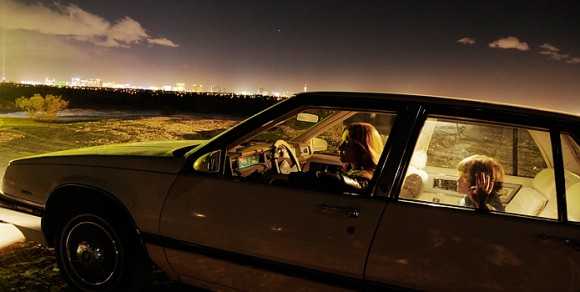 By Adam Nayman
By Adam Nayman
Bryan Wizemann’s drama sees Wendy and Lucy and raises it: its desperate, cash-strapped female protagonist also abandons her dog to a better life without her, but only as a rehearsal for attempting to do the same thing with her young daughter. Shades also of L’Enfant, then, but the Dardennes’ genius lies in making it seem as if their skilfully contrived narratives are unfolding as a result of their characters’ actions. While Think of Me never lapses as far into insulting contrivance as some other recent American indie films (such as Chris Weitz’s mechanical Bicycle Thieves homage A Better Life), one still gets the feeling that the movie is happening to worn-out yet still hot-to-trot single mom Angela (Lauren Ambrose). Not content with sticking her in a shitty call-centre job and saddling her with a dilapidated car, the screenplay also robs her of the seed money she’d been saving and forces her to repeatedly make conversation with creepy Amer-indie axiom Dylan Baker.
Baker’s casting is maybe a case of gilding the lily in a film whose every bit of foreshadowing is ominous. When his character mentions that his sister in Toronto had tried to adopt a child but it fell through, we know it’s just a matter of time before he sets his gimlet eyes on Angela’s little moppet (“Hi cutie,” smirks Baker whenever he sees the child, playing slyly off his sick-fuck Solondzian reputation). What holds the movie together (more than Ambrose’s perpetually scrunched-up-and-on-the verge-of-tears performance) is Wizemann’s knack for staging and locations, playing down Las Vegas glamour in favour of believably faded neighbourhood backdrops. And, at the other end of the visual spectrum, he rescues the car wash from being a locus of existential dread a la Egoyan, Haneke, or Cronenberg—a minor accomplishment, but we’ll take what we can get.
The Year of the Tiger (Sebastián Lelio, Chile)—Vanguard
 By Robert Koehler
By Robert Koehler
A case of improvisation alternating with dramatic calculation, director Sebastián Lelio and screenwriter Gonzalo Maza’s film is probably best viewed as a dark night of the soul for the modern Chilean era, where old faiths and habits are giving way to secular skepticism. The 1755 Lisbon earthquake triggered the Enlightenment, so perhaps the 2010 Chilean earthquake might cause a similar shift in thinking. When the quake hits, prisoner Manuel (Luis Dubo) takes advantage of the chaos to escape, but soon finds that his family members have been killed. Some unfortunate symbolic touches and an overextended and obvious face-off with a nasty farmer deflate the film just when it seems about to reach something notable. But the film’s intersection of actual events with the staging of actors amidst the chaos recalls some of the sublime, existential sequences in Kiarostami’s Life and Nothing More, which also integrated fiction inside of the disaster left behind by the Guilan earthquake.
cscope2

